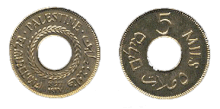Mill (currency unit)
| Currency symbols | |
|---|---|
| Symbols of valid currencies and tokens | ฿ - ₵ - ¢ - ₡ - ₫ - € - ƒ - ₲ - ₭ - ₾ - £ - ₤ - ₺ - ₼ - ₥ - ₦ - ₱ ₽ - ₹ - ₨ - ৲ - ৳ - $ - ₮ - ₩ - ¥ - ₴ - ₪ - 〒 |
| Symbols of no longer valid currencies and tokens | ₳ - ₢ - ₡ - ₰ - ₯ - ₠ - ₣ - ℳ - ₧ - ℛℳ |
A mill ( ₥ , from lat. Millesimum : "thousandth part") is a currency sub-unit with the value of one thousandth of a currency . Alternative spellings are Mil, Mils, Millieme, French Millième or Arabic Millīm (مليم) . It was or is mainly in use in former British colonies .
use
United States
With the introduction of the US dollar in 1792 it was determined that it could be divided into ten dime , one hundred cents or one thousand mill. From 1793 to 1857 half-cent coins with a value of 5 mill were minted, but never coins with “mill” as face value.
Until the 1960s, however, some US states and sometimes private companies issued tokens valued at one to nine million. These were mainly used to pay sales tax on purchases. The brands were mostly made from cheap materials such as aluminum , plastic or paper . However, rising inflation made production so unprofitable that its use was practically discontinued in the 1960s.
In some cases, however, prices are still given to the millimeter, especially fuel at the petrol station or electricity, and rounded to cents when paying.
Egypt
The Egyptian pound is in 100 piastres ( Arabic قرش Qirsch ) or 1000 Millim (Millièmes). However, there are no longer any Millièmes coins in circulation; the smallest coin is currently the 5 piaster coin.
Sudan
The (old) Sudanese pound was also subdivided into 100 piastres / qirsch or 1000 millimeters until 1991.
Israel
The Israeli pound was divided into 1,000 mils until 1949 and 1,000 prutots until 1960 . There were coins of 25 mil, later of 1 pruta as well as 5, 10, 25, 50, 100 and 250 prutot.
Libya
The Libyan pound was divided into 1000 millimeters or 100 piasters until 1971 , when it was replaced by the Libyan dinar at 1000 dirhams .
Malta
Before the introduction of the euro , the Maltese lira was divided into 100 cents or 1000 mils and coins were minted at 2, 3 and 5 mils.
Palestine and Transjordan
The Palestinian pound (1927–1950) was divided into 1,000 mils. Coins of 1, 2, 5, 10, 20, 50 and 100 mils were minted and banknotes of 500 mils were printed.
Tunisia
The Tunisian dinar is divided into 1000 millim . The 5 millim coin is currently the smallest valid coin in circulation, but is no longer minted.
Cyprus
In Cyprus , with the introduction of the decimal system in 1955 , the Cyprus pound was divided into 1000 mils. Coins of 1, 3, 5, 10, 25, 50 and 100 mils were minted, and banknotes of 250 and 500 mils were minted. In 1983 the mil was replaced by the cent (£ 1 = 100 ¢). A ½-cent coin was initially minted, which corresponded to the 5-mil coin, but was soon withdrawn from circulation.
Comparable currency units
- The Kuwaiti Dinar , the Iraqi Dinar and the Bahraini Dinar are each divided into 1000 fils . The Kuwaiti 5 fils coin is currently the coin with the lowest face value.
- The Omani Rial is divided into 1000 Baisa. The 5 Baisa coin is currently the smallest valid coin in circulation.
- The Japanese yen is formally divided into 100 sen or 1000 rin , but all coins with a face value below 1 yen were suspended in 1953.
- The British pound was before the introduction of the decimal system in 960 Farthings divided. The smallest British coin in the 19th century had a face value of ¼ farthing.


